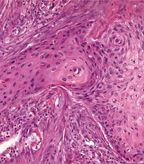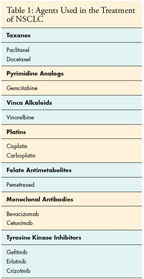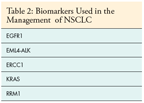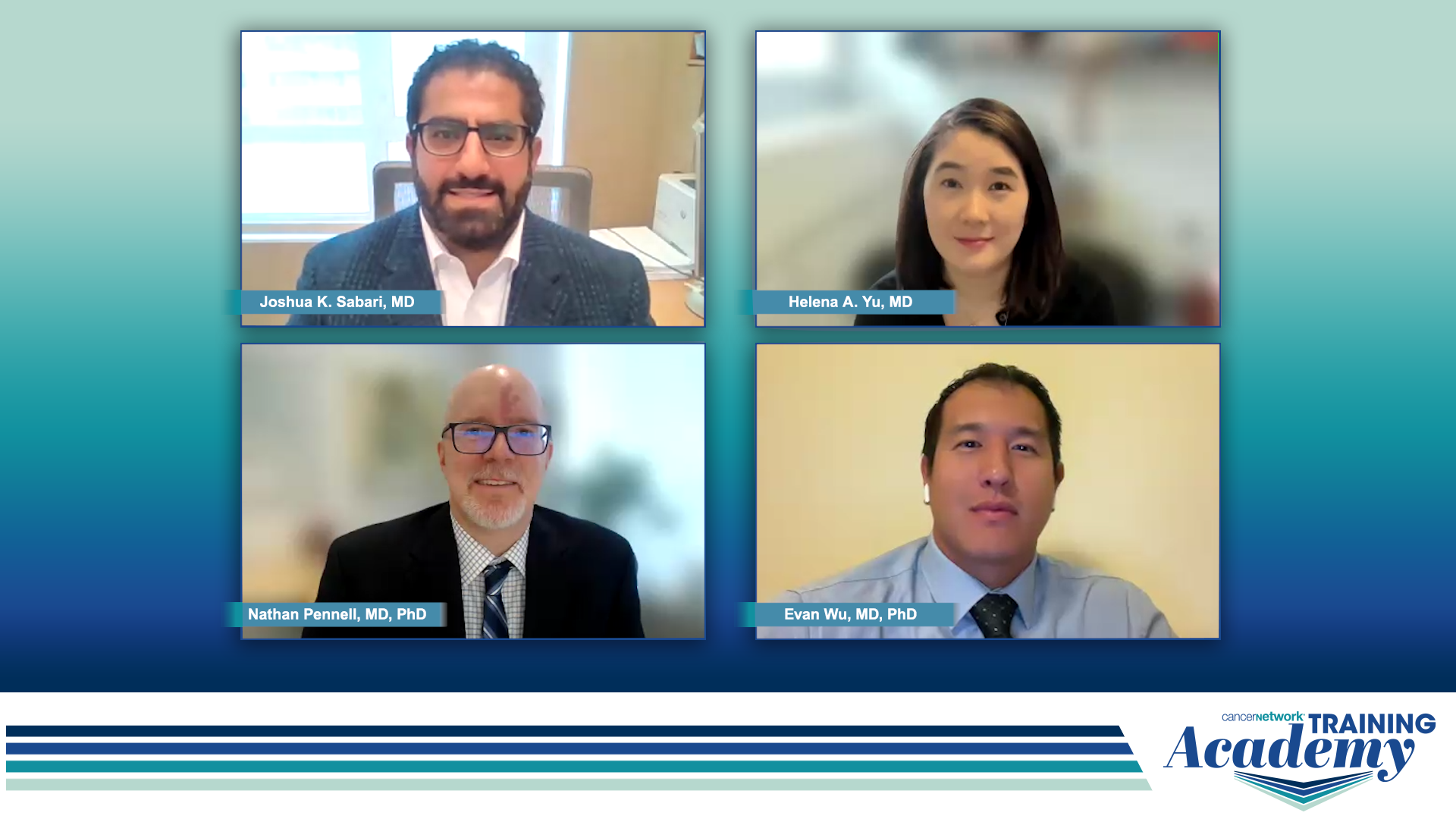Current Treatment Options for Non–Small-Cell Lung Cancer
Chemotherapy is now employed in earlier-stage disease in neoadjuvant, adjuvant, and combined-modality treatments. The aim of this article is to review the current systemic treatments for NSCLC.

ABSTRACT: Non–small-cell lung cancer (NSCLC) remains a difficult-to-treat malignancy, and durable long-term survival is elusive for patients with advanced-stage disease. Chemotherapy, especially with platinum-based combinations, is the mainstay of treatment, yet these regimens yield only modest response and survival rates. Outcomes of recent clinical trials have shown that histology, mutation analyses, and biomarkers have an impact on the selection and combination of chemotherapeutic agents. Oral tyrosine kinase inhibitors and monoclonal antibodies are now part of the treatment schema. Other changes to the treatment paradigm include the duration of treatment and the use of maintenance therapy. Additionally, chemotherapy is now employed in earlier-stage disease in neoadjuvant, adjuvant, and combined-modality treatments. The aim of this article is to review the current systemic treatments for NSCLC.
A variety of agents and drug combinations (see Table 1) are used for the management of patients with non–small-cell lung cancer (NSCLC), depending on the stage of the disease and a number of patient factors that will be discussed in this article.
Doublet Therapy: Histology Matters
TABLE 1

Agents Used in the Treatment of NSCLC
Cisplatin-based combinations (doublets) continue to be the cornerstone of treatment for patients with advanced NSCLC, following results of early studies that demonstrated a modest 1-year survival benefit (20% to 25%) with this modality.[1] For years, researchers have tried to determine the most effective doublet therapy, in terms of patient response and survival. Results of phase III clinical trials have shown equivocal response and survival rates in NSCLC patients treated with third-generation agents-such as the taxanes (paclitaxel and docetaxel), gemcitabine, and vinorelbine-combined with a platinum (either cisplatin or carboplatin).[2]
In 2008, Scagliotti et al published the findings of their phase III study comparing the efficacy of cisplatin-based doublets (gemcitabine, pemetrexed [Alimta]) in untreated patients with advanced-stage NSCLC. Although both combinations had equivocal efficacy, the main finding of the meta-analysis was that patients with either adenocarcinoma or large cell carcinoma who had received cisplatin-pemetrexed had better survival rates than those treated with cisplatin-gemcitabine. It should be noted that patients with squamous cell carcinoma treated with the cisplatin-gemcitabine combination had improved survival rates compared with patients who received the cisplatin-pemetrexed doublet. This study was the first to demonstrate survival differences based on histology.[3] Based on the results of this phase III clinical trial, histology is a significant factor in selection of chemotherapeutic agents for patients with untreated, advanced-stage NSCLC.
There is still some question as to which platin (cisplatin or carboplatin) is the more effective agent. Numerous studies have tried to answer this question.[2,4–6] Both drugs have benefits and toxicities. Treatment with cisplatin requires pre- and post-treatment hydration, thus prolonging the treatment time.[7] Side effects of cisplatin include, but are not limited to, nausea, vomiting, neurotoxicity, nephrotoxicity, and ototoxicity. Nausea and vomiting are better controlled with newer antiemetic medications.
Carboplatin side effects are milder nausea and vomiting (compared with cisplatin) and hematologic issues such as thrombocytopenia. Both drugs are associated with hypersensitivity reactions.[8]
Results of a meta-analysis demonstrated better response and prolonged survival for patients who received cisplatin-based therapy.[4] There was not a higher incidence of severe (grade 3 or 4) side effects in the cisplatin group compared with those who received carboplatin.[4] The American Society of Clinical Oncology (ASCO) and the National Comprehensive Cancer Network (NCCN) guidelines support using either cisplatin or carboplatin for patients with advanced NSCLC[7]; therefore, treatment planning for the patient with NSCLC is determined by histology, performance status, age, and comorbidities.
Triplet Therapy
For years, researchers have been investigating various combinations of drugs and other means of overcoming the plateau effect of standard chemotherapy. Early clinical trials using three cytotoxic chemotherapy agents (triplet therapy) were tried, with the result that triplet therapy was more toxic and did not improve survival rates compared with doublet therapy.[9,10] The consensus among investigators is that newer agents, with a different toxicity profile and mechanism of action, are needed to improve the response and survival rates.[7,11,12] Some targeted therapies, such as the monoclonal antibodies bevacizumab (Avastin) and cetuximab (Erbitux), have been combined with chemotherapy in clinical trials.[7]
In 2006, the US Food and Drug Administration (FDA) approved bevacizumab as first-line treatment for advanced NSCLC in combination with carboplatin and paclitaxel.[7] Bevacizumab is a recombinant monoclonal antibody that prevents vascular endothelial growth factor (VEGF) from binding to its receptor, thereby slowing tumor growth and preventing metastasis. Results of a phase III clinical trial randomizing untreated patients with advanced NSCLC to carboplatin and paclitaxel with or without bevacizumab demonstrated a survival benefit for patients who received all three drugs.[13] Subsequent clinical trials have also shown response and survival benefit with the addition of bevacizumab to doublet chemotherapy.[7] Both the ASCO and NCCN treatment guidelines recommend combining bevacizumab with chemotherapy, based on clinical trial findings.[14,15]
Cetuximab has also been studied in clinical trials. It targets the epidermal growth factor receptor (EGFR) pathway at the extracellular level, preventing ligands from binding with the EGFR receptors.[16] The results of two phase III clinical trials demonstrated slightly improved response and survival rates for those who received cetuximab with chemotherapy.[17,18] Currently, cetuximab is approved for the treatment of metastatic colorectal cancer and squamous cell head and neck cancer, but not for advanced NSCLC.[7]
Tyrosine Kinase Inhibitors as First-Line Therapy
Small tyrosine kinase inhibitors (TKIs) target the intracellular EGFR pathways, thereby blocking downstream signaling as well as growth and proliferation of cancer.[7] Two such agents are gefitinib (Iressa) and erlotinib (Tarceva). Results of phase III randomized clinical trials comparing chemotherapy plus an oral TKI (gefitinib, erlotinib) against chemotherapy alone did not show improved survival with addition of the oral TKI.[19–22] Therefore, oral TKIs in combination with chemotherapy were not approved for first-line treatment of patients with advanced NSCLC.
Recent studies have evaluated the oral TKIs as monotherapy (single-agent) first-line treatment for advanced NSCLC. One large phase III trial, the Iressa Pan-Asia Study (IPASS), randomized untreated East Asian patients to chemotherapy (carboplatin and paclitaxel) or gefitinib; the results demonstrated improved response and progression-free survival rates for patients who received gefitinib.[23]
Another phase III randomized clinical trial evaluated erlotinib vs carboplatin-gemcitabine as first-line treatment for NSCLC. This was a smaller study in which 549 patients were screened but 384 patients were excluded because their tumor did not express the EGFR-activating mutation (exon 19 deletion or exon 21 L858R point mutation); therefore, 165 patients were randomized to the two arms. Once again, the results demonstrated longer progression-free survival for patients who received erlotinib.[24] Based on the findings from these two studies, and from other clinical trials that demonstrated longer survival with an oral EGFR TKI agent over chemotherapy, the NCCN recommends erlotinib as first-line therapy in patients whose tumors express the EGFR-activating mutation.[15]
Crizotinib (Xalkori), another small-molecule agent, may also be used as first-line treatment providing that the patient’s tumor expresses the EML4-ALK mutation, and that this mutation status is known at the time of treatment intiation. (Crizotinib was approved by the FDA in August 2011 for treatment of NSCLC patients whose tumors express the EML4-ALK mutation.) If the mutation status is not known (the mutation test results are pending), then the oncologist can delay treatment (if the patient agrees to wait) until notified of the results or just begin treatment with other agents. If, after treatment is started, the patient’s tumor does express the EML4-ALK mutation, then crizotinib could be used after initial treatment is completed (see section on Second and Third-Line Therapy). NCCN guidelines recommend crizotinib as first-line therapy for patients with the EML4-ALK mutation.[15]
Maintenance Therapy
One of the newer roles of chemotherapy, at least in lung cancer, is that of maintenance therapy. The idea behind maintenance therapy, long used in hematologic malignancies, is to prevent the cancer from recurring, and, in some cases, to maintain the responses achieved with first-line therapy.[7] Continuation maintenance therapy is defined as: “continuation of one or more drugs used during first-line therapy beyond four to six cycles.” Switch maintenance therapy is alternative therapy (with a chemotherapy agent different from that used in first-line therapy) given to patients who have had response or stabilization of disease after four to six cycles of first-line therapy. Maintenance therapy is used when there is stabilization of disease, whereas second-line therapy is used for patients with disease progression.[25]
Pemetrexed and erlotinib were the first two drugs approved by the FDA for maintenance therapy in patients with lung cancer.[7] Results of a phase III randomized study showed some improvement in progression-free and overall survival for patients who received pemetrexed rather than best supportive care following first-line platinum-based chemotherapy.[26] It should be noted that in this study, pemetrexed was not used in the first-line platinum-based treatment.
In 2010, erlotinib was approved for use in maintenance therapy based on results of the SATURN (Sequential Tarceva in Unresectable NSCLC) trial.[7,27] In this study, patients were eligible to participate following completion of four courses of cisplatin-based chemotherapy with stable disease (without evidence of disease progression), and were randomized to erlotinib or placebo. Immunohistochemistry testing for EGFR protein overexpression was performed for all study participants. The results demonstrated longer progression-free survival for patients who received erlotinib, regardless of EGFR expression status.[27]
ASCO’s updated treatment guidelines recommend discontinuing first-line treatment for NSCLC after four courses of chemotherapy in patients who have stable disease but no further response (decrease in tumor size) to treatment.[25] The ASCO guidelines call for doublet chemotherapy as first-line treatment, for at least four but no more than six cycles of treatment; for patients who have stable disease or a response after four chemotherapy treatments, the guidelines recommend immediate treatment with an “alternative, single-agent chemotherapy.” The agents recommended for switch maintenance therapy are pemetrexed, for patients with nonsquamous histology; erlotinib, for patients whose EGFR mutation status may or may not be known or positive; and docetaxel, for all patients regardless of histology. If patients have significant toxicities with first-line doublet therapy, the guidelines state that it is also reasonable to give them a break from treatment, and not administer maintenance therapy.
Chemotherapy in Neoadjuvant and Adjuvant Treatment
Chemotherapy has long been the primary treatment for patients with advanced, metastatic NSCLC. Researchers have evaluated the use of chemotherapy in earlier stages of disease to enhance survival. Findings from a meta-analysis of seven randomized clinical trials, totaling 988 patients with stages I to IIIA disease, showed significant benefit for patients who received platinum-based chemotherapy before surgery compared with those who did not receive chemotherapy.[28]
Adjuvant therapy is now standard treatment for patients who have had surgery. Results of the International Adjuvant Lung Cancer Trial Collaborative Group (IALT) showed higher survival rates for patients who received postoperative cisplatin-based chemotherapy.[29] The findings of the IALT group were confirmed by the Lung Adjuvant Cisplatin Evaluation (LACE) Group. The LACE group completed a meta-analysis of five randomized clinical trials, with a total of 4,584 patients, which validated survival benefit for patients who receive cisplatin-based chemotherapy.[30]
Second- and Third-Line Treatment
There are now many options available to the patient with disease progression following first-line chemotherapy. Any chemotherapy agent that is different from first-line therapy and not used as maintenance therapy could be employed for disease recurrence/progression. The chemotherapy agents recommended for second-line therapy are the same ones recommended for maintenance therapy: docetaxel, pemetrexed, and erlotinib.[7] The results of two phase III clinical trials showed response and survival benefit for patients who received docetaxel as second-line therapy.[31,32] Another phase III clinical trial compared docetaxel vs pemetrexed in the second-line setting.[33] The response rates were similar in both treatment arms. One of the differences between the two treatment arms was that there were higher hematologic toxicities in the docetaxel arm, but both docetaxel and pemetrexed are reasonable treatment choices in the second-line setting.
Erlotinib is approved for treatment in both the second- and third-line settings.[7] The approval of erlotinib in these settings is based on results of an international randomized clinical trial of erlotinib vs best supportive care. The results demonstrated improvement in response and survival rates and in quality of life, and a decrease in cancer-related symptoms.[34]
For second- or third-line treatment, there is yet another option for selected patients with advanced NSCLC. Crizotinib received accelerated FDA approval in August 2011, to treat certain patients with locally advanced or metastatic NSCLC who express the abnormal anaplastic lymphoma kinase (ALK) gene.[35] The approval of crizotinib was based on response rates, not survival data. Currently, two phase III studies of crizotinib are underway, with the endpoint of progression-free survival.[36]
Biomarkers
TABLE 2

Biomarkers Used in the Management of NSCLC
Treatment selection is now based on histology and biomarkers, which have prognostic and predictive value (see Table 2). The prognostic value of a biomarker is in determining which tumors are likely to recur and lead to death, regardless of the treatment. Predictive markers indicate which patients would respond to certain agents, and would be helpful in selecting patients for appropriate treatment. The following are used as biomarkers in NSCLC: EGFR, ERCC1, RRM1, KRAS, and EML4-ALK.[37] Mutation of EGFR has predictive value in terms of response to EGFR-inhibitor agents such as erlotinib.[23]
The excision-repair cross-complementation group 1 (ERCC1) is an enzyme protein that is involved in the final step of the nuclear excision repair (NER) pathway, which is one of the DNA repair pathways.[37] The NER pathway recognizes and repairs platinum-DNA adducts that are formed when cisplatin binds to DNA, causing strand breaks that inhibit replication and lead to cell death.[38,39] When high levels of ERCC1 are present, the damaged cell is able to repair itself and is therefore platinum-resistant; conversely, low ERCC1 levels suggest platinum sensitivity.[39,40]
The enzyme ribonucleotide reductase is composed of two subunits, RRM1 and RRM2, both of which are required for DNA synthesis and repair. The chemotherapy agent gemcitabine targets RRM1 by inhibiting ribonucleotide reductase, and thereby blocking the DNA synthesis pathway. When RRM1 overexpression is present, it can overcome the chemotherapeutic effects of gemcitabine, rendering the drug ineffective.[37]
RAS proteins are proto-oncogenes that are involved in signal transduction pathways. KRAS is one of three genes in the RAS “family” and has a role in cell growth and signaling.[41,42] There is a substitution of a purine for a pyrimidine in the KRAS mutation.[43] In lung cancer, KRAS mutations are associated with resistance to both EGFR inhibitors and chemotherapy.[43]
The echinoderm microtubule-associated protein-like 4 gene (EML4) and the anaplastic lymphoma kinase gene are two separate genes located on chromosome 2p.[37] The EML4-ALK gene is the fusion of these two separate genes.[36] The presence of the fusion gene, in transgenic mouse models, leads to the development of numerous lung adenocarcinomas.[44] Further research demonstrated that cancer cell lines that had the EML4-ALK mutation were effectively inhibited by ALK inhibitors.[45] The knowledge of these biomarkers will enable the oncology team to select beneficial treatment for patients with NSCLC.
Conclusion
In treating advanced NSCLC, the paradigm has shifted. Treatment is now determined by histology, biomarkers, and holistic assessment (age, performance status, comorbidities). Treatment for NSCLC now follows a personalized approach. Slowly, progress is being made for treatments aimed at a minority of patients whose tumors have gene mutations, with improvement in response and survival rates. There is still work to be done to improve response and survival outcomes for patients with NSCLC whose tumors do not express gene mutations.
Financial Disclosure:The author has no significant financial interest or other relationship with the manufacturers of any products or providers of any service mentioned in this article.
References:
References
1. Chemotherapy in non-small cell lung cancer: A meta-analysis using updated data on individual patients from 52 randomized clinical trials. Non-Small Cell Lung Cancer Collaborative Group. Brit Med J 311:899â909, 1995.
2. Schiller JH, Harrington D, Belani C, et al: Comparison of four chemotherapeutic regimens for advanced non-small cell lung cancer. NEngl J Med 346:92â98, 2002.
3. Scagliotti GV, Parikh P, von Pawel J, et al: Phase III study comparing cisplatin plus gemcitabine with cisplatin plus pemetrexed in chemotherapy-naive patients with advanced-stage non-small cell lung cancer. JClin Oncol 26(21):3543â3551, 2008.
4. Ardizzoni A, Boni L, Tiseo M, et al, for the CISCA (Cisplatin versus Carboplatin) Meta-Analysis Group: Cisplatin versus carboplatin-based chemotherapy in first-line treatment of advanced non-small cell lung cancer: An individual patient meta-analysis. J Natl Cancer Inst 99:847â857, 2007.
5. Hotta K, Matsuo K, Ueoka H, et al: Meta-analysis of randomized clinical trials comparing cisplatin to carboplatin in patients with advanced non-small cell lung cancer. J Clin Oncol 22:3852â3859, 2004.
6. Soria JC, LeChevalier T: Is cisplatin still the best platinum compound in non-small cell lung cancer? Ann Oncol 13:1515â1517, 2002.
7. Tyson LB, Ginex PK: Non-small cell lung cancer, in Houlihan NG, Tyson LB (eds): Site-Specific Cancer Series: Lung Cancer. Pittsburgh, PA, Oncology Nursing Society Publications Department, 2012, pp 99â130.
8. Castells M, Maatulonis UA: Infusion reactions to systemic chemotherapy [2010]. Available at http://www.uptodate.com/contents/infusion-reactions-to-systemic-chemotherapy. Accessed on June 5, 2012.
9. Govindan R: Chemotherapy for metastatic non-small cell lung cancer: Current status and future directions. Natl Clin Pract Oncol 5(2):238â239, 2005.
10. Rudd RM, Gower NH, Spiro SG, et al: Gemcitabine plus carboplatin versus mitomycin, ifosfamide, and cisplatin in patients with stage IIIB or IV non-small cell lung cancer: A phase III randomized study of the London Lung Cancer Group. J Clin Oncol 23(1):142â153, 2005.
11. Gridelli C, Maione P, Rossi A, et al: The role of bevacizumab in the treatment of non-small cell lung cancer: Current indications and future developments. The Oncologist 12:1183â1193, 2007.
12. Wang G, Reed E, Li QQ: Molecular basis of cellular response to cisplatin chemotherapy in non-small cell lung cancer. Oncol Reports 12(5):955â965, 2004.
13. Sandler A, Gray R, Perry MC, et al: Paclitaxel-carboplatin alone or with bevacizumab for non-small cell lung cancer. N Engl J Med 355(24):2542â2550, 2006.
14. Azzoli CG, Baker S Jr, Temin S, et al: ASCO Clinical Practice Guideline: Update on chemotherapy for stage IV non-small cell lung cancer. J Clin Oncol 27(36):6251â6266, 2009.
15. National Comprehensive Cancer Network (2012). NCCN Clinical Practice Guidelines in Oncology: Non-small cell lung cancer [v2.2012]. Available at http://www.nccn.org/professionals/physician_gls/pdf/nscl/pdf. Accessed on June 5, 2012.
16. Blumenschein Jr GR, Paulus R, Curran WJ, et al: Phase II study of cetuximab in combination with chemoradiation in patients with stage IIIA/B non-small-cell lung cancer: RTOG 0324. J Clin Oncol 29(17):2312â2318, 2011.
17. Pirker R, Pereira JR, Szczesna A, et al: Cetuximab plus chemotherapy in patients with advanced non-small cell lung cancer (FLEX): An open-label randomized phase III trial. Lancet 373:1525â1531, 2009.
18. Lynch TJ, Patel T, Dreisbach L, et al: Cetuximab and first-line taxane/carboplatin chemotherapy in advanced non-small cell lung cancer: Results of the randomized multicenter phase III trial BMS099. J Clin Oncol 28(6):911â917, 2010.
19. Gatzemeier U, Pluzanka A, Szczesna A, et al: Phase III study of erlotinib in combination with cisplatin and gemcitabine in advanced non-small cell lung cancer: The Tarceva Lung Cancer Investigation Trial. J Clin Oncol 25(12):1545â1552, 2007.
20. Giaccone G, Herbst RS, Manegold C, et al: Gefitinib in combination with gemcitabine and cisplatin in advanced non-small cell lung cancer: A phase III trial-INTACT I. J Clin Oncol 23(4):777â784, 2004.
21. Herbst RS, Giaccone G, Schiller JH, et al: Gefitinib in combination with paclitaxel and carboplatin in advanced non-small cell lung cancer: A phase III trial-INTACT 2. J Clin Oncol 23(4):785â794, 2004.
22. Herbst RS, Prager D, Hermann R, et al: TRIBUTE: A phase III trial of erlotinib hydrochloride (OSI 774) combined with carboplatin and paclitaxel in advanced non-small cell lung cancer. J Clin Oncol 23(25):5892â5899, 2005.
23. Mok TS, Wu YL, Thongprasert S, et al: Gefitinib or carboplatin-paclitaxel in pulmonary adenocarcinoma. N Engl J Med 361(10):947â957, 2009.
24. Zhou C, Wu YL, Chen G, et al: Erlotinib versus chemotherapy as first-line treatment for patients with advanced EGFR mutation-positive non small cell lung cancer (OPTIMAL, CTONG-0802): A multicentre, open-label, randomised, phase 3 study. Lancet Oncol 12:735â742, 2011.
25. Azzoli CG, Temin S, Aliff T, et al: 2011 Focused update of 2009 American Society of Clinical Oncology clinical practice guideline update on chemotherapy for stage IV non-small cell lung cancer. J Clin Oncol 29(28):3825â3831, 2011.
26. Ciuleanu T, Brodowicz T, Zielinski C, et al: Maintenance pemetrexed plus best supportive care versus placebo plus best supportive care for non-small lung cancer: A randomised, double-blind, phase 3 study. Lancet 374(9699):1432â1440, 2009.
27. Cappuzzo F, Ciuleanu T, Stelmakh L, et al, on behalf of the SATURN investigators. Lancet Oncol 11(6):521â529, 2010.
28. Burdett S, Stewart LA, Rydzewska LA: A systematic review and meta-analysis of the literature: Chemotherapy and surgery versus surgery alone in non-small cell lung cancer. J Thoracic Oncol 1(7):611â621, 2006.
29. Arriagada R, Bergman B, Le Chevalier T, et al: Cisplatin-based adjuvant chemotherapy in patients with completely resected non-small cell lung cancer. N Engl J Med 350(4):351â360, 2004.
30. Pignon JP, Tribodet H, Scagliotti GV, et al: Lung adjuvant cisplatin evaluation: A pooled analysis by the LACE collaborative group. J Clin Oncol 26(21):3552â3559, 2008.
31. Fossella FV, DeVore R, Kerr RN, et al, and the TAX Non-Small-Cell Lung Cancer Study Group. Randomized phase III trial of docetaxel versus vinorelbine or ifosfamide in patients withadvanced non-small cell lung cancer previously treated with platinum containing chemotheapy regimens. J Clin Oncol 18(12):2354â2362, 2000.
32. Shepherd FA, Dancey J, Ramlau R, et al: Prospective randomized trial of docetaxel versus best supportive care in patients with non-small cell lung cancer previously treated with platinum-based chemotherapy. J Clin Oncol 18(12):2095â2103, 2000.
33. Hanna N, Shepherd FA, Fossella FV, et al: Randomized phase III trial of pemetrexed versus docetaxel in patients with non-small-cell lung cancer previously treated with chemotherapy. J Clin Oncol 22(9):1589â1597, 2004.
34. Shepherd FA, Pereira JR, Ciuleanu T, et al, for the National Cancer Institute of Canada Clinical Trials Group. Erlotinib in previously treated non-small cell lung cancer. N Engl J Med 353(2):123â132, 2005.
35. Shaw AT, Solomon B, Kenudson MM: Crizotinib and testing for ALK. J Natl Compr Canc Netw 9(12):1335â1341, 2011.
36. Shaw AT, Solomon B: Anaplastic Lymphoma Kinase (ALK) Fusion Gene Positive Advanced Non-Small Cell Lung Cancer [2011]. Available at http://www.uptodate.com/contents/anaplastic-lymphoma-kinase-alk-fusion-gene-positive-advanced-non-small-cell-lung-cancer. Accessed June 4, 2012.
37. Kreamer K, Eaby-Sandy B, Sherry V: Biomarkers in non-small cell lung cancer: Opportunity and challenge. J Adv PractOncol 2(3):163â175, 2011.
38. Neumann AS, Sturgis E, Wei Q: Nucleotide excision repair as a marker for susceptibility to tobacco-related cancers: A review of molecular epidemiology studies. Molec Carcinog 42(2):65â92, 2005.
39. Aggarwal C, Somaiah N, Simon GR: Biomarkers with predictive and prognostic function in non-small cell lung cancer: Ready for prime time? J Natl Compr Canc Netw 8(7):822â832, 2010.
40. Simon G, Sharma A, Li X, et al: Feasibility and efficacy of molecular analysis-directed individualized therapy in advanced non-small cell lung cancer. J Clin Oncol 25(19):2741â2746, 2007.
41. Baselga J, Rosen N: Determinants of resistance to anti-epidermal growth factor receptor agents. J Clin Oncol 26(10):1582â1584, 2008.
42. Zhu C, Zhu CQ, da Cunha Santos G, et al: Role of KRAS and EGFR as biomarkers of response to erlotinib in National Cancer Institute of Canada Clinical Trials Group study BR. 21. J Clin Oncol 26(26):4268â4275, 2008.
43. Herbst RS, Heymach JV, Lippmann SM: Molecular origins of cancer: Lung cancer. N Engl J Med 359(13):1367â1380, 2008.
44. Soda M, Choi Y, Enomoto M, et al: Identification of the transforming EML4-ALK fusion gene in non-small cell lung cancer. Nature 448:561â566, 2007.
45. Kwak EL, Camidge DR, Clark J: Clinical activity observed in a phase I dose escalation trial of an oral c-met and ALK inhibitor, PF-02341066. J Clin Oncol 27(suppl 15s): abstract 3509, 2009.
Newsletter
Stay up to date on recent advances in the multidisciplinary approach to cancer.











